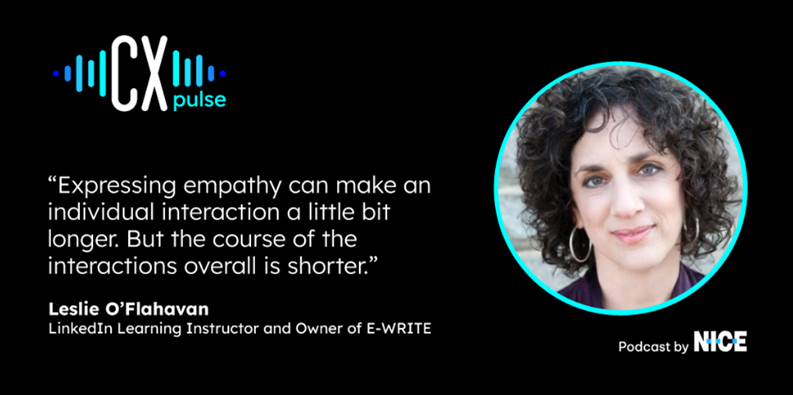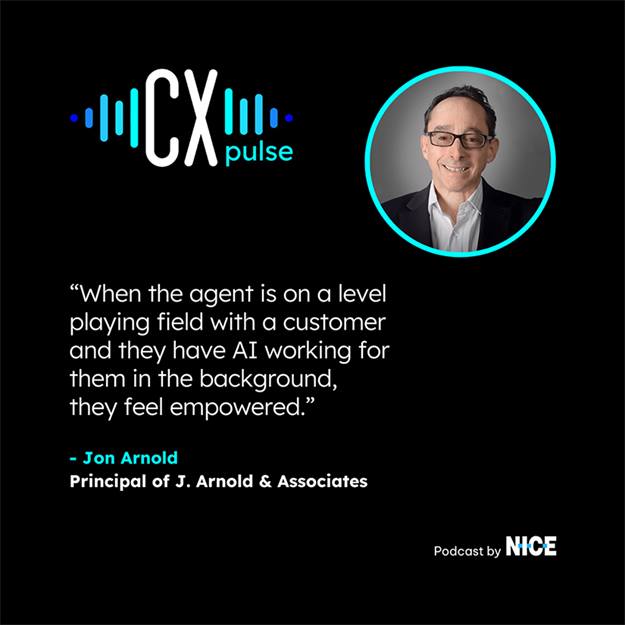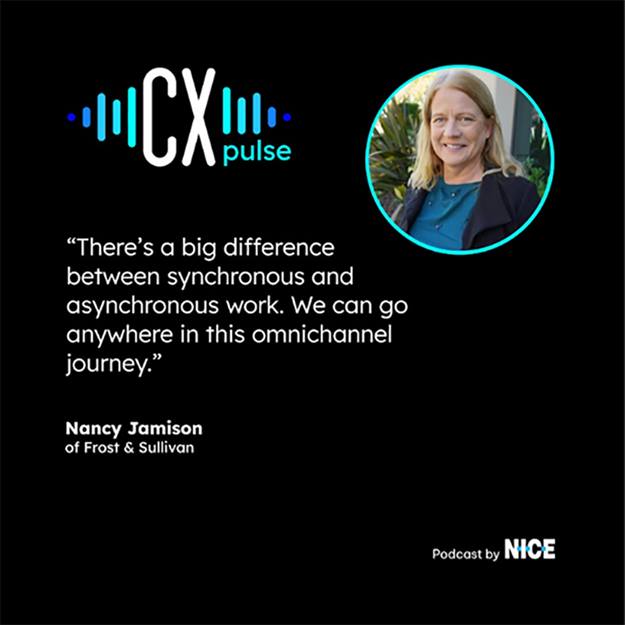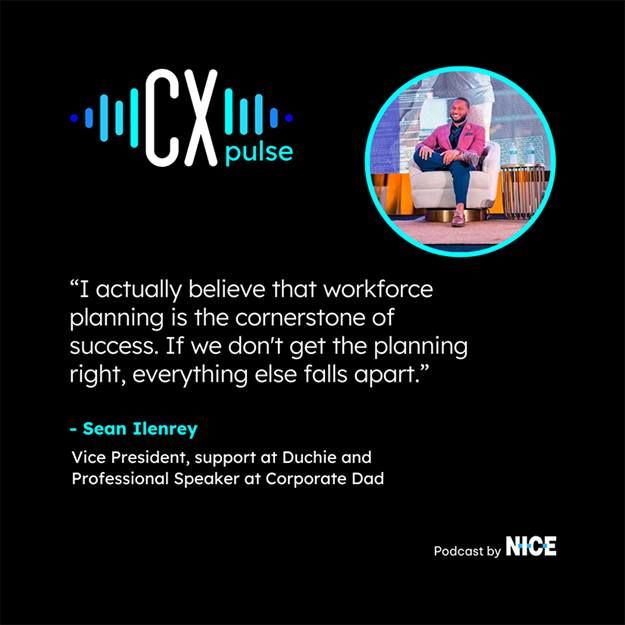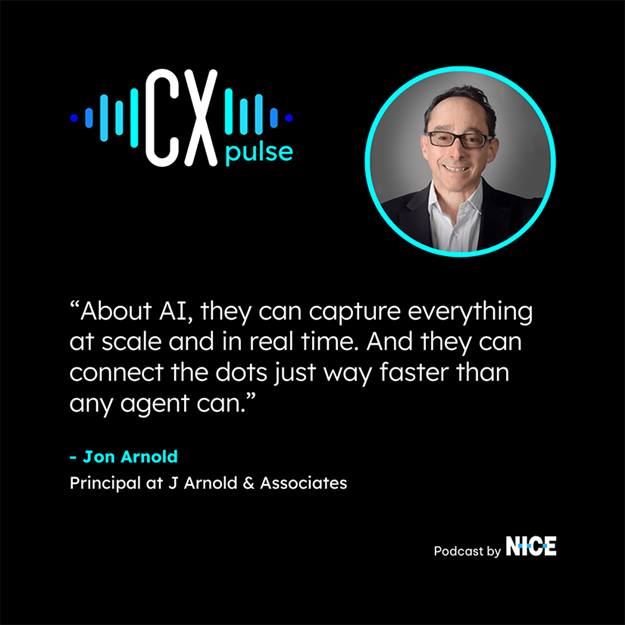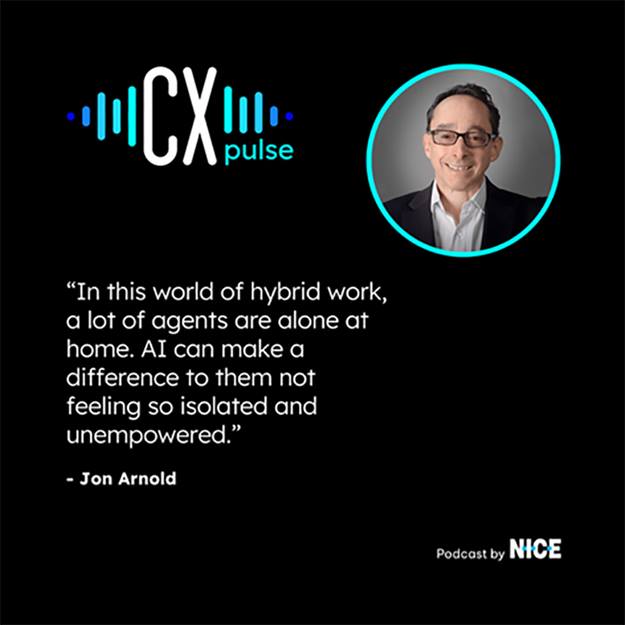How can advanced contact center technology make a difference for both contact center agents and your customers? These experts unpack how digital and AI are changing the workplace and the conversations.
Engaged, satisfied customer agents perform better on the job. With the right tools, employees refine their interactions with customers to be personalized and effective, pleasing customers and also making agents feel good about their performance. AI is the key component of today’s tools to engage contact center agents, providing everything from next best steps in real time to scheduling flexibility.
We spoke with several contact center experts in a series of CX Pulse podcasts about the steps to empower agents to create positive customer interactions.
Generating Empathy with AI in Contact Centers
Leslie O’Flahavan, owner of E-WRITE, a writing consultancy, talks about how empathy from contact center agents to customers can lead to dramatically improved KPIs. O’Flahavan argues that the demonstrations of empathy don’t need to come at the cost of efficiency, either, or be difficult to teach and implement.
Agents are often hard pressed to balance empathy and efficiency in their communications with customers. Supervisors ask them to express nominal forms of empathy to help calm customers, explains O’Flahavan, yet not express too much empathy, otherwise the conversation may get off track and take too long—or even pose a legal risk.
“What they’re offered instead as a connection behavior with customers is apology—the more stale the apology, the more common it is—‘we regret any inconvenience this may have caused,’ which is the world’s most stale apology,” O’Flahavan said. These short statements are easy to learn and repeat, but they end up doing little to allay the situation and may instead escalate it.
AI’s power to understand language and sentiment can help in these situations. O’Flahavan says that AI tools can generate scripted responses for common or especially painful situations that the agent can use. She gives the example, “If you’re an airline that’s had a technical glitch, AI really can help you, because there is an aspect of agent exhaustion that will tap out their ability to express empathy, and the AI systems can really support in that case.”
And empathy can be learned—listen to the podcast on Spotify, Apple or YouTube to hear how O’Flahavan helped one cellular company to tweak their apologies for a dramatic improvement to their KPIs.
AI in the Contact Center
Jon Arnold, principal analyst at J Arnold & Associates, discusses how AI is transforming contact center operations. He argues that customer experiences have actually gotten worse in the last 20 years. “There’s a big chasm between what contact centers can use with their existing tech to support, customers, and what customers are used to getting in their own world when they have all these applications and capabilities at their fingertips,” he said.
AI in the contact center can help bridge this gap.
“AI can tap a much, much richer set of data that you already have about your customer, but also new forms of data that you couldn’t capture before,” he said.
This takes out the guesswork for agents, he explains further, because agents can be ready when calls come in, creating informed, intelligent conversations with the customer.
Arnold argues that empowering agents with AI tools can help them boost their KPIs and morale, helping to retain them as employees. “[With AI] agents now say ‘I don’t think I know what your problems are, I know what your problems are, and I know you’re going to like what I’m about to tell you.’ That totally changes the dynamic, and that makes the agent feel great,” he said.
Tune in to the episode on Spotify, Apple or YouTube to hear more on Arnold’s advice on just which tools contact centers should start with among all the AI tools available.
Leveraging Digital Channels in Today’s Ever-Evolving Workspace
Nancy Jamison, analyst at Frost & Sullivan, talks about all the ways to take advantage of the digital channels available in today’s evolving CX workspace.
There are stereotypes about generational preferences for communication channels—older people prefer phone calls, while younger ones prefer digital self-service—but Jamison cautions that these are only generalities. She explains that because of the pandemic, many people had to use digital forms of communication out of necessity and are now more comfortable with it. On the flip side, the pandemic forced companies to adopt digital channels in order to reach their customers.
Now, many more people use self-service options. And it's not just the pandemic that has driven digital channel adoption—Jamison argues that the maturation of AI and speech technology have done so too.
Digital channels have deeply affected workforce management in contact centers. Jamison notes that there is a world of difference between synchronous and asynchronous channels, shaking up workforce planning. Asynchronous interactions come in via digital channels, and they may or may not be addressed immediately.
Furthermore, they can be spread out over hours or even days, handled by multiple employees. These characteristics don’t fit the usual planning standards based on phone calls that are answered and resolved at once. Jamison argues that a new system of tracking these interactions is needed in order to forecast and plan agent workloads accurately.
Tune into the podcast on Spotify, Apple or YouTube to hear about the performance gap between companies that adopt digital channels and AI tools and those companies that don’t.
Doing More with Less in the Contact Center
Sean Ilenrey, vice president, support at Dutchie, and professional speaker, Corporate Dad, talks about how contact centers can do more with less in times of economic uncertainty while still maintaining high customer satisfaction.
Ilenrey discusses one of the most important set of skills that agents can have today—and those are resilient soft skills. “I say it’s so important right now for our employees to hone in on resilient, soft skills,” he said. “What that means is, as you continue to work, we tend to get burned out a little bit. So how do you maintain that on each transaction?” Ilenrey also notes that contact centers are expecting to do more with less from a hiring standpoint, putting further pressure on developing skills in employees.
Agents can develop these skills with the right tools and support. Ilenrey says that agents tend to get overwhelmed at first when they are tasked with developing these soft skills, but when management can show that they support their employees with appropriate coaching and training, then agents respond positively.
Ilenrey highlights the importance of accurate planning to contact center success. “Unfortunately, if you get it wrong, it creates challenges at every other single opportunity, whether it’s scheduling or real-time, [and] when you’re hiring and planning, it can take three to six months in order to fully ramp and onboard an employee,” he said. Giving agents the ability to self-swap shifts makes a difference to them, Ilenrey explains, since it gives them a level of flexibility and empowerment over their lives.
Listen to the podcast on Spotify, Apple or YouTube to hear Ilenrey’s advice to make working from home a success, and how Batman’s technology is like state-of-the-art contact center tools.
Detecting Fraud Through Agent Training and AI Tools
Jon Arnold, principal at J Arnold & Associates, returns to discuss the methods fraudsters use to gain access to sensitive data via contact center agents.
Arnold says that a common way that fraudsters try to scam businesses via contact centers is by impersonating a known customer. “They may have stolen somebody’s debit card at an ATM machine, or they may have pickpocketed somebody’s wallet. . . Once they find out where that customer shops, they’re going to go for those brands, and then they’re going to call in as if they are that customer,” Arnold explains.
In all these cases, the fraudster uses a script to interact with the agent. And this is where AI can be incredibly useful, Arnold says, because it’s very good at detecting patterns. He further explains that AI tools ingest all the interactions of a contact center, recognizes patterns, and once a specific pattern is associated with fraud, AI can quickly identify other callers who are executing the scam.
And how can organizations keep their agents vigilant against these fraudulent calls and texts? Arnold gives three pieces of advice. First, organizations can acknowledge the problem and train their agents to recognize typical scenarios. Second, having technology that tracks interactions in real time is critical, so having systems in the cloud is important. Third, using AI tools to take in all interactions in real time is key—those tools can inform the supervisor or agent right away if there’s something amiss, so they can take action during the call, not after the damage has already been done.
Listen to the podcast on Spotify, Apple or YouTube to hear about other types of fraud that impact the contact center—when scammers impersonate contact center agents to scam your customers.
Unlocking the Transformative Power of AI in Customer Experience
Jon Arnold returned to CX Pulse to talk about AI’s pivotal role in using the digital transformation in customer experience. For Arnold, AI has immense potential, “As the world moves on from analog pieces to digital equivalents—everything from physical objects, the way we talk, the way we record things, to the way we just do everything—the more things become digital, the more they generate new data, [and] that is the lifeblood for AI.”
One way to leverage AI is to “make agents much more informed, intelligent, and empowered,” he said. AI tools can give them information about the customer at hand, helping them to personalize the interaction to the customer’s preferences, truly delighting the customer in the process.
AI tools can serve to assist agents, supporting them in helping customers, and not threaten their own livelihoods. “[Agents] have to be viewed as partners in this. They’ve got to be trained properly, compensated properly, and made to feel that these tools are there to make their jobs easier and better—not to replace them,” Arnold said. This makes the position more rewarding for what would be an otherwise undesirable job.
In the new world of hybrid work, AI can help with remote training and support. Arnold says that AI can look at patterns of top-performing agents, figure out the best practices, then share that with new agents to help them feel valued in the role.
Tune in to the podcast on Spotify, Apple or YouTube to hear how contact centers can go beyond siloed ways of thinking about AI and attain holistic views that can transform contact center operations and customer experiences.




